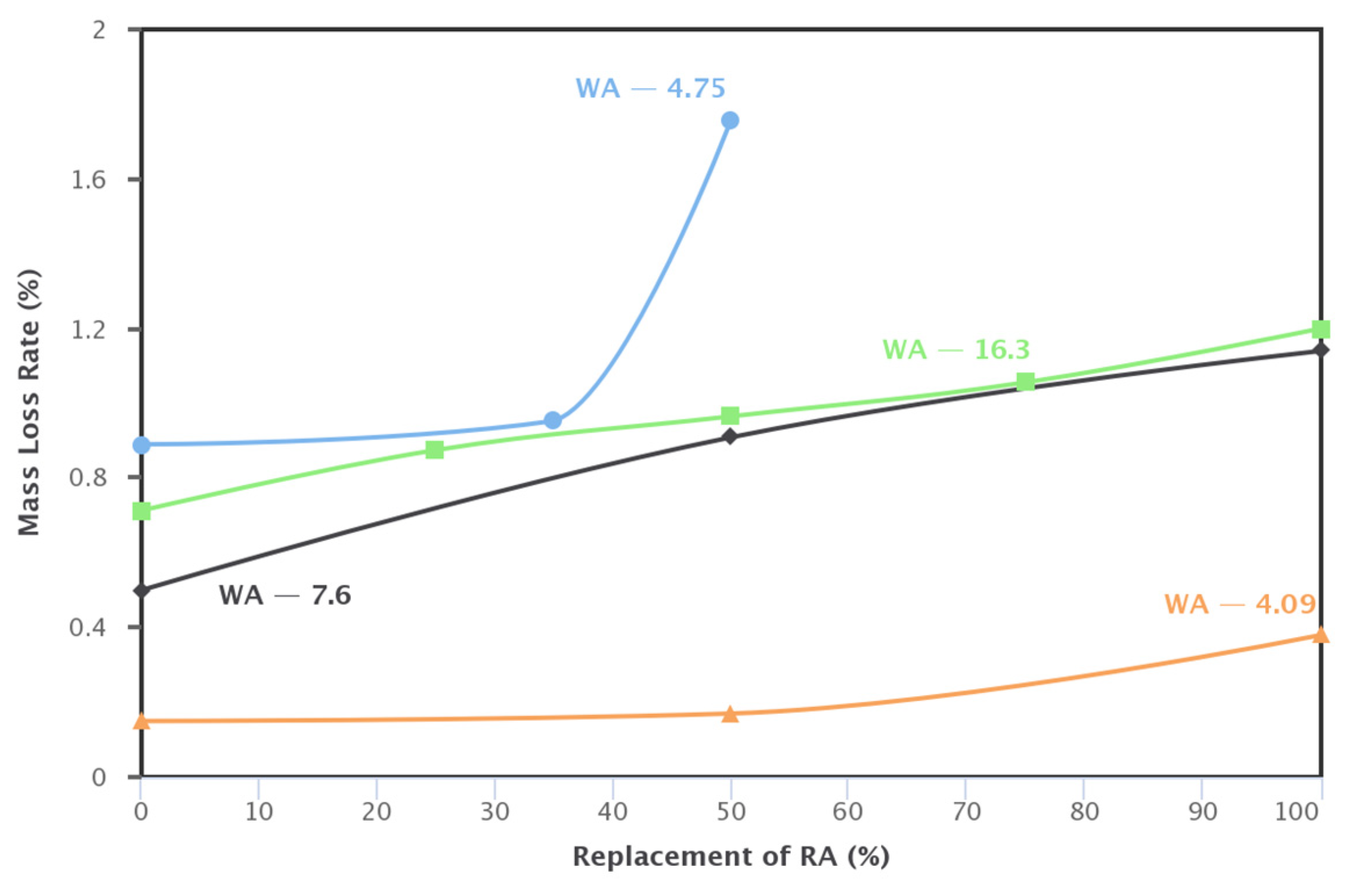A Comprehensive Review on Recycling of Construction Demolition Waste in Concrete
Abstract
1. Introduction
Significance of the Review
2. Literature Review on Recycled Aggregate
2.1. Composition of Recycled Aggregate
| Literature | Aggregate Type | Country | SiO2 (%) | CaO (%) | Al2O3 (%) |
|---|---|---|---|---|---|
| Nedeljkovi et al. [34] | FRCA | Netherland | 66.4 | 21.5 | 5.0 |
| Alexandridou et al. [31] | FMRA | Northern Greece | 34.3 | 27.52 | 6.4 |
| CMRA | 18.4 | 39.5 | 3.6 | ||
| FMRA | Southern Greece | 10.9 | 45.2 | 2.03 | |
| CMRA | 8.3 | 47.6 | 1.7 | ||
| Moreno-Pérez et al. [35] | FMRA | Canada | 51.5 | 19.6 | 13.7 |
| CMRA | 51.1 | 23.3 | 13.2 | ||
| Angulo et al. [36] | FMRA | Brazil | 73.9 | 5.45 | 7.0 |
| CMRA | 67.1 | 7.8 | 9.8 | ||
| Kirthika et al. [37] | FMRA | India | 68.9 | 4.5 | 11.5 |
| Silva et al. [32] | CMRA | Brazil | 52.4 | 15.6 | 11.6 |
| Sivamani et al. [33] | FMRA | India | 71.2 | 14.13 | 5.51 |
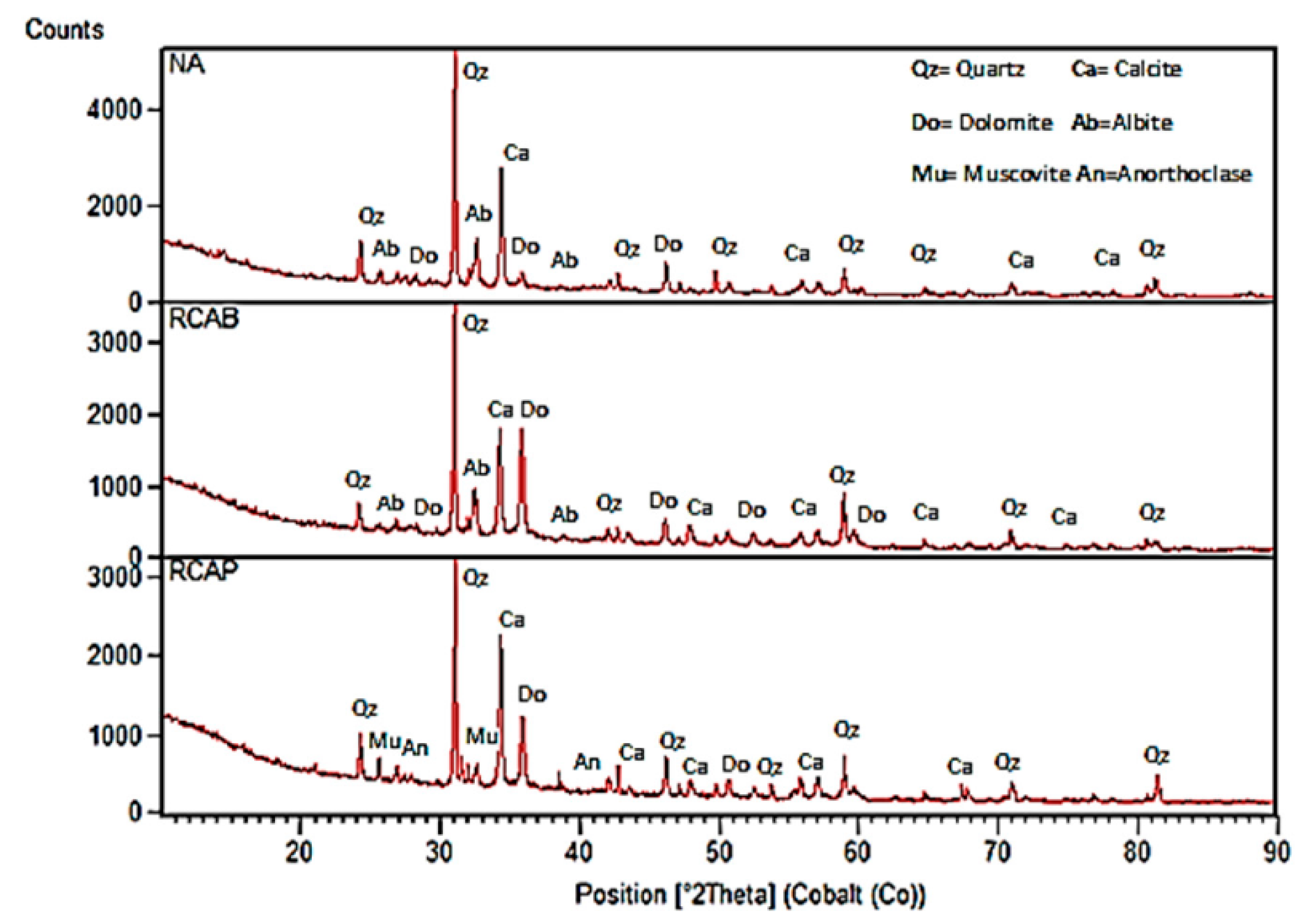
2.2. Treatment of Recycled Aggregate
2.3. Fresh Concrete Properties
2.4. Properties of Hardened Concrete
2.5. Supplementary Cementitious Materials
2.6. Frost Resistance
3. Scientometric Review of Recycled Concrete Aggregate Research
3.1. Top-Cited Articles
3.2. Keyword Co-Occurrence and Evolution Analysis
4. Current Trends and Future of Recycled Aggregates
5. Discussion
6. Conclusions
- The water absorption rate of recycled concrete aggregate can be reduced using various methods, such as carbonation treatment, the addition of supplementary cementitious materials with a two-stage mixing approach, hydrochloric acid, H2SO4 acid, and acetic acid immersion treatments, impregnation with calcium metasilicate, the addition of pozzolanic slurry (nano-SiO2, silica fume, and fly ash slurry), the addition of a superfine powder (phosphorous slag, ground granulated blast furnace slag, and fly ash) with a superplasticizer, heating–scrubbing, and the immersion of RCA in a crystallization agent.
- We discuss the strengths and weaknesses of each improvement method, including the mixing approach, acid treatment, carbonation treatment, and the addition of pozzolanic material. The addition of pozzolanic materials and pre-soaking using nanomaterials effectively and economically improved the detrimental effects of recycled aggregates.
- The optimum level of replacement of different pozzolanic materials with recycled concrete aggregate was found to be 7% for silica fume, a liquid-to-solid ratio of 10:1 for silica fume slurry, a combination of 10% superfine phosphorous slag with 10% GGBS, a combination of 60% GGBS and 7% lime, and 3% replacement of nano-silica. In addition, a combination of fly ash, slag, and silica fume was found to mitigate the adverse effect of RCA and improve the mechanical properties.
- The top-cited articles and keyword co-occurrence visualization provided us with the most- and least-studied areas, which may help us to improve the research field further.
Author Contributions
Funding
Institutional Review Board Statement
Informed Consent Statement
Data Availability Statement
Acknowledgments
Conflicts of Interest
References
- Silva, R.V.; De Brito, J.; Dhir, R.K. Properties and composition of recycled aggregates from construction and demolition waste suitable for concrete production. Constr. Build. Mater. 2014, 65, 201–217. [Google Scholar] [CrossRef]
- Rezaiee-Pajand, M.; Abad, J.M.N.; Karimipour, A.; Rezaiee-Pajand, A. Propose new implement models to determine the compressive, tensile and flexural strengths of recycled coarse aggregate concrete via imperialist competitive algorithm. J. Build. Eng. 2021, 40, 102337. [Google Scholar] [CrossRef]
- Chen, S.-C.; Zou, S.-Y.; Hsu, H.-M. Effects of Recycled Fine Aggregates and Inorganic Crystalline Materials on the Strength and Pore Structures of Cement-Based Composites. Crystals 2021, 11, 587. [Google Scholar] [CrossRef]
- Joseph, H.S.; Pachiappan, T.; Avudaiappan, S.; Flores, E.I.S. A Study on Mechanical and Microstructural Characteristics of Concrete Using Recycled Aggregate. Materials 2022, 15, 7535. [Google Scholar] [CrossRef] [PubMed]
- Ju, H.; Yerzhanov, M.; Serik, A.; Lee, D.; Kim, J. Statistical and Reliability Study on Shear Strength of Recycled Coarse Aggregate Reinforced Concrete Beams. Materials 2021, 14, 3321. [Google Scholar] [CrossRef] [PubMed]
- Jian, S.-M.; Wu, B. Compressive behavior of compound concrete containing demolished concrete lumps and recycled aggregate concrete. Constr. Build. Mater. 2020, 272, 121624. [Google Scholar] [CrossRef]
- Ahmed, H.; Tiznobaik, M.; Huda, S.B.; Islam, M.S.; Alam, M.S. Recycled aggregate concrete from large-scale production to sustainable field application. Constr. Build. Mater. 2020, 262, 119979. [Google Scholar] [CrossRef]
- Makul, N.; Fediuk, R.; Amran, M.; Zeyad, A.M.; Murali, G.; Vatin, N.; Klyuev, S.; Ozbakkaloglu, T.; Vasilev, Y. Use of Recycled Concrete Aggregates in Production of Green Cement-Based Concrete Composites: A Review. Crystals 2021, 11, 232. [Google Scholar] [CrossRef]
- Ariyachandra, E.; Peethamparan, S.; Patel, S.; Orlov, A. Effect of NO2 sequestered recycled concrete aggregate (NRCA) on mechanical and durability performance of concrete. Cem. Concr. Res. 2020, 137, 106210. [Google Scholar] [CrossRef]
- Cantero, B.; Bravo, M.; de Brito, J.; del Bosque, I.S.; Medina, C. Mechanical behaviour of structural concrete with ground recycled concrete cement and mixed recycled aggregate. J. Clean. Prod. 2020, 275, 122913. [Google Scholar] [CrossRef]
- Liu, S.; Shen, P.; Xuan, D.; Li, L.; Sojobi, A.; Zhan, B.; Poon, C.S. A comparison of liquid-solid and gas-solid accelerated carbonation for enhancement of recycled concrete aggregate. Cem. Concr. Compos. 2021, 118, 103988. [Google Scholar] [CrossRef]
- Wang, X.; Yang, X.; Ren, J.; Han, N.; Xing, F. A novel treatment method for recycled aggregate and the mechanical properties of recycled aggregate concrete. J. Mater. Res. Technol. 2021, 10, 1389–1401. [Google Scholar] [CrossRef]
- Kumar, G.S. Synergetic effect of a chemical activator and blast-furnace slag on enhancing recycled aggregate mortar. Mag. Concr. Res. 2020, 72, 471–485. [Google Scholar] [CrossRef]
- Kumar, G.S.; Saini, P.K.; Karade, S.R.; Minocha, A.K. Chemico-thermal treatment for quality enhancement of recycled concrete fine aggregates. J. Mater. Cycles Waste Manag. 2019, 21, 1197–1210. [Google Scholar] [CrossRef]
- Saini, P.K.; Karade, S.R. Impact of Mixing Approaches on Properties of Recycled Aggregate Mortar. ACI Mater. J. 2020, 117. [Google Scholar] [CrossRef]
- Bao, J.; Li, S.; Zhang, P.; Ding, X.; Xue, S.; Cui, Y.; Zhao, T. Influence of the incorporation of recycled coarse aggregate on water absorption and chloride penetration into concrete. Constr. Build. Mater. 2019, 239, 117845. [Google Scholar] [CrossRef]
- Rattanachu, P.; Toolkasikorn, P.; Tangchirapat, W.; Chindaprasirt, P.; Jaturapitakkul, C. Performance of recycled aggregate concrete with rice husk ash as cement binder. Cem. Concr. Compos. 2020, 108, 103533. [Google Scholar] [CrossRef]
- Wang, J.J.; Xie, J.H.; Wang, C.H.; Zhao, J.B.; Liu, F.; Fang, C. Study on the optimum initial curing condition for fly ash and GGBS based geopolymer recycled aggregate concrete. Constr. Build. Mater. 2020, 247, 21. [Google Scholar] [CrossRef]
- Qureshi, L.A.; Ali, B.; Ali, A. Combined effects of supplementary cementitious materials (silica fume, GGBS, fly ash and rice husk ash) and steel fiber on the hardened properties of recycled aggregate concrete. Constr. Build. Mater. 2020, 263, 120636. [Google Scholar] [CrossRef]
- Mehrabi, P.; Shariati, M.; Kabirifar, K.; Jarrah, M.; Rasekh, H.; Trung, N.T.; Shariati, A.; Jahandari, S. Effect of pumice powder and nano-clay on the strength and permeability of fiber-reinforced pervious concrete incorporating recycled concrete aggregate. Constr. Build. Mater. 2021, 287, 122652. [Google Scholar] [CrossRef]
- Xiong, Z.; Wei, W.; Liu, F.; Cui, C.; Li, L.; Zou, R.; Zeng, Y. Bond behaviour of recycled aggregate concrete with basalt fibre-reinforced polymer bars. Compos. Struct. 2020, 256, 113078. [Google Scholar] [CrossRef]
- Bao, J.; Yu, Z.; Wang, L.; Zhang, P.; Wan, X.; Gao, S.; Zhao, T. Application of ferronickel slag as fine aggregate in recycled aggregate concrete and the effects on transport properties. J. Clean. Prod. 2021, 304, 127149. [Google Scholar] [CrossRef]
- Deng, D. A Fast-Developing Market, An Insight into China’s Construction and Demolition Waste Recycling Industry. 2022. Available online: https://www.investni.com/media-centre/features/insight-chinas-construction-and-demolition-waste-recycling-industry (accessed on 3 January 2023).
- U.S. Environmental Protection Agency. Facts and Figures about Materials, Construction and Demolition Debris: Material-Specific Data. 2022. Available online: https://www.epa.gov/facts-and-figures-about-materials-waste-and-recycling/construction-and-demolition-debris-material#C&Dtableandgraph (accessed on 3 January 2023).
- Centre for Science and Environment, Building Material Promotion Council. 2020. Available online: https://www.cseindia.org/india-manages-to-recover-and-recycle-only-about-1-per-cent-of-its-construction-and-demolition-10326 (accessed on 3 January 2023).
- National Waste Report 2022, Blue Environment. 2022. Available online: https://www.dcceew.gov.au/sites/default/files/documents/national-waste-report-2022.pdf (accessed on 3 January 2023).
- Adams, K. Department for Environment Food & Rural Affairs, Construction Products Association. 2018. Available online: https://www.constructionproducts.org.uk/media/557062/how-much-construction-waste-is-there.pdf (accessed on 3 January 2023).
- European Environmental Agency. Construction and Demolition Waste: Challenges and Opportunities in a Circular Economy. 2021. Available online: https://www.eea.europa.eu/publications/construction-and-demolition-waste-challenges (accessed on 3 January 2023).
- Building Waste: Recycling under Scrutiny, French Agency for Environment and Energy Management. 2021. Available online: https://learnandconnect.pollutec.com/en/building-waste-recycling-under-scrutiny/ (accessed on 3 January 2023).
- National Center for Waste and Circular Economy of the National Institute for Environmental Protection and Research. Report on Waste from Economic Activities. 2021. Available online: https://www.isprambiente.gov.it/files2021/pubblicazioni/rapporti/rapportorifiutispeciali_ed-2021_n-345bis_versionedati-di-sintesi_en.pdf (accessed on 3 January 2023).
- Alexandridou, C.; Angelopoulos, G.N.; Coutelieris, F.A. Mechanical and durability performance of concrete produced with recycled aggregates from Greek construction and demolition waste plants. J. Clean. Prod. 2018, 176, 745–757. [Google Scholar] [CrossRef]
- da Silva, S.R.; Cimadon, F.N.; Borges, P.M.; Schiavon, J.Z.; Possan, E.; Andrade, J.J.D.O. Relationship between the mechanical properties and carbonation of concretes with construction and demolition waste. Case Stud. Constr. Mater. 2022, 16, e00860. [Google Scholar] [CrossRef]
- Sivamani, J.; Renganathan, N.T. Effect of fine recycled aggregate on the strength and durability properties of concrete modified through two-stage mixing approach. Environ. Sci. Pollut. Res. 2021, 29, 85869–85882. [Google Scholar] [CrossRef]
- Nedeljković, M.; Visser, J.; Nijland, T.G.; Valcke, S.; Schlangen, E. Physical, chemical and mineralogical characterization of Dutch fine recycled concrete aggregates: A comparative study. Constr. Build. Mater. 2020, 270, 121475. [Google Scholar] [CrossRef]
- Moreno-Pérez, E.; Hernández-Ávila, J.; Rangel-Martínez, Y.; Cerecedo-Sáenz, E.; Arenas-Flores, A.; Reyes-Valderrama, M.I.; Salinas-Rodríguez, E. Chemical and Mineralogical Characterization of Recycled Aggregates from Construction and Demolition Waste from Mexico City. Minerals 2018, 8, 237. [Google Scholar] [CrossRef]
- Angulo, S.; Ulsen, C.; John, V.; Kahn, H.; Cincotto, M. Chemical–mineralogical characterization of C&D waste recycled aggregates from São Paulo, Brazil. Waste Manag. 2009, 29, 721–730. [Google Scholar] [CrossRef]
- Yu, Z.; Shan, Y.; Huang, Q.; Sun, X. Failure Criteria and Mechanical Properties of Recycled Concrete with Different Replacement Ratios of Coarse Aggregates under Multiaxial Compression. J. Mater. Civ. Eng. 2019, 31, 04019216. [Google Scholar] [CrossRef]
- Sánchez-Cotte, E.H.; Pacheco-Bustos, C.A.; Fonseca, A.; Triana, Y.P.; Mercado, R.; Yepes-Martínez, J.; Espinoza, R.G.L. The Chemical-Mineralogical Characterization of Recycled Concrete Aggregates from Different Sources and Their Potential Reactions in Asphalt Mixtures. Materials 2020, 13, 5592. [Google Scholar] [CrossRef]
- Imtiaz, T.; Ahmed, A.; Hossain, S.; Faysal, M. Microstructure Analysis and Strength Characterization of Recycled Base and Sub-Base Materials Using Scanning Electron Microscope. Infrastructures 2020, 5, 70. [Google Scholar] [CrossRef]
- Chen, C.; Liu, R.; Zhu, P.; Liu, H.; Wang, X. Carbonization Durability of Two Generations of Recycled Coarse Aggregate Concrete with Effect of Chloride Ion Corrosion. Sustainability 2020, 12, 10544. [Google Scholar] [CrossRef]
- Zhang, J.; Shi, C.; Li, Y.; Pan, X.; Poon, C.-S.; Xie, Z. Performance Enhancement of Recycled Concrete Aggregates through Carbonation. J. Mater. Civ. Eng. 2015, 27, 04015029. [Google Scholar] [CrossRef]
- Faysal, R.; Maslehuddin, M.; Shameem, M.; Ahmad, S.; Adekunle, S.K. Effect of mineral additives and two-stage mixing on the performance of recycled aggregate concrete. J. Mater. Cycles Waste Manag. 2020, 22, 1587–1601. [Google Scholar] [CrossRef]
- Kavussi, A.; Hassani, A.; Kazemian, F.; Taghipoor, M. Laboratory evaluation of treated recycled concrete aggregate in asphalt mixtures. Int. J. Pavement Res. Technol. 2019, 12, 26–32. [Google Scholar] [CrossRef]
- Hamad, B.S.; Dawi, A.H.; Daou, A.; Chehab, G.R. Studies of the effect of recycled aggregates on flexural, shear, and bond splitting beam structural behavior. Case Stud. Constr. Mater. 2018, 9, e00186. [Google Scholar] [CrossRef]
- Kumar, R.; Gurram, S.C.B.; Minocha, A.K. Influence of recycled fine aggregate on microstructure and hardened properties of concrete. Mag. Concr. Res. 2017, 69, 1288–1295. [Google Scholar] [CrossRef]
- Cantero, B.; del Bosque, I.S.; Matías, A.; de Rojas, M.S.; Medina, C. Inclusion of construction and demolition waste as a coarse aggregate and a cement addition in structural concrete design. Arch. Civ. Mech. Eng. 2019, 19, 1338–1352. [Google Scholar] [CrossRef]
- Sim, J.; Park, C. Compressive strength and resistance to chloride ion penetration and carbonation of recycled aggregate concrete with varying amount of fly ash and fine recycled aggregate. Waste Manag. 2011, 31, 2352–2360. [Google Scholar] [CrossRef]
- Guo, Z.; Chen, C.; Lehman, D.E.; Xiao, W.; Zheng, S.; Fan, B. Mechanical and durability behaviours of concrete made with recycled coarse and fine aggregates. Eur. J. Environ. Civ. Eng. 2017, 24, 171–189. [Google Scholar] [CrossRef]
- Raman, J.V.M.; Ramasamy, V. Augmentation of dissimilar techniques for enhancing the concrete properties with recycled coarse aggregate and manufactured sand. J. Mater. Res. Technol. 2021, 14, 1180–1190. [Google Scholar] [CrossRef]
- Babalola, O.E.; Awoyera, P.; Tran, M.; Le, D.-H.; Olalusi, O.B.; Viloria, A.; Ovallos-Gazabon, D. Mechanical and durability properties of recycled aggregate concrete with ternary binder system and optimized mix proportion. J. Mater. Res. Technol. 2020, 9, 6521–6532. [Google Scholar] [CrossRef]
- Mahmood, W.; Khan, A.-U.; Ayub, T. Mechanical and Durability Properties of Concrete Containing Recycled Concrete Aggregates. Iran. J. Sci. Technol. Trans. Civ. Eng. 2021, 46, 2111–2130. [Google Scholar] [CrossRef]
- Zhan, B.J.; Xuan, D.X.; Zeng, W.; Poon, C.S. Carbonation treatment of recycled concrete aggregate: Effect on transport properties and steel corrosion of recycled aggregate concrete. Cem. Concr. Compos. 2019, 104, 103360. [Google Scholar] [CrossRef]
- Zeng, W.; Zhao, Y.; Zheng, H.; Poon, C.S. Improvement in corrosion resistance of recycled aggregate concrete by nano silica suspension modification on recycled aggregates. Cem. Concr. Compos. 2019, 106, 103476. [Google Scholar] [CrossRef]
- Al-Waked, Q.; Bai, J.; Kinuthia, J.; Davies, P. Enhancing the aggregate impact value and water absorption of demolition waste coarse aggregates with various treatment methods. Case Stud. Constr. Mater. 2022, 17, e01267. [Google Scholar] [CrossRef]
- Al-Bayati, H.K.A.; Das, P.K.; Tighe, S.L.; Baaj, H. Evaluation of various treatment methods for enhancing the physical and morphological properties of coarse recycled concrete aggregate. Constr. Build. Mater. 2016, 112, 284–298. [Google Scholar] [CrossRef]
- Damrongwiriyanupap, N.; Wachum, A.; Khansamrit, K.; Detphan, S.; Hanjitsuwan, S.; Phoo-Ngernkham, T.; Sukontasukkul, P.; Li, L.-Y.; Chindaprasirt, P. Improvement of recycled concrete aggregate using alkali-activated binder treatment. Mater. Struct. 2021, 55, 1–20. [Google Scholar] [CrossRef]
- Shi, C.; Wu, Z.; Cao, Z.; Ling, T.C.; Zheng, J. Performance of mortar prepared with recycled concrete aggregate enhanced by CO2 and pozzolan slurry. Cem. Concr. Compos. 2018, 86, 130–138. [Google Scholar] [CrossRef]
- Wang, H.-L.; Wang, J.-J.; Sun, X.-Y.; Jin, W.-L. Improving performance of recycled aggregate concrete with superfine pozzolanic powders. J. Cent. South Univ. 2013, 20, 3715–3722. [Google Scholar] [CrossRef]
- Purushothaman, R.; Amirthavalli, R.R.; Karan, L. Influence of Treatment Methods on the Strength and Performance Characteristics of Recycled Aggregate Concrete. J. Mater. Civ. Eng. 2015, 27, 04014168. [Google Scholar] [CrossRef]
- Wang, L.; Wang, J.; Qian, X.; Chen, P.; Xu, Y.; Guo, J. An environmentally friendly method to improve the quality of recycled concrete aggregates. Constr. Build. Mater. 2017, 144, 432–441. [Google Scholar] [CrossRef]
- Savva, P.; Ioannou, S.; Oikonomopoulou, K.; Nicolaides, D.; Petrou, M. A Mechanical Treatment Method for Recycled Aggregates and Its Effect on Recycled Aggregate-Based Concrete. Materials 2021, 14, 2186. [Google Scholar] [CrossRef] [PubMed]
- Saravanakumar, P.; Abhiram, K.; Manoj, B. Properties of treated recycled aggregates and its influence on concrete strength characteristics. Constr. Build. Mater. 2016, 111, 611–617. [Google Scholar] [CrossRef]
- Prasad, D.; Pandey, A.; Kumar, B. Sustainable production of recycled concrete aggregates by lime treatment and mechanical abrasion for M40 grade concrete. Constr. Build. Mater. 2020, 268, 121119. [Google Scholar] [CrossRef]
- Kim, Y.; Hanif, A.; Kazmi, S.M.; Munir, M.J.; Park, C. Properties enhancement of recycled aggregate concrete through pretreatment of coarse aggregates–Comparative assessment of assorted techniques. J. Clean. Prod. 2018, 191, 339–349. [Google Scholar] [CrossRef]
- Sun, C.; Chen, L.; Xiao, J.; Singh, A.; Zeng, J. Compound utilization of construction and industrial waste as cementitious recycled powder in mortar. Resour. Conserv. Recycl. 2021, 170, 105561. [Google Scholar] [CrossRef]
- Verma, A.; Babu, V.S.; Srinivasan, A. Strength and Durability Properties of Treated Recycled Aggregate Concrete by Soaking and Mechanical Grinding Method: Influence of Processing Technique. J. Mater. Civ. Eng. 2021, 33, 04021286. [Google Scholar] [CrossRef]
- Li, L.; Xuan, D.; Chu, S.; Lu, J.X.; Poon, C.S. Efficiency and mechanism of nano-silica pre-spraying treatment in performance enhancement of recycled aggregate concrete. Constr. Build. Mater. 2021, 301, 124093. [Google Scholar] [CrossRef]
- Mistri, A.; Dhami, N.; Bhattacharyya, S.K.; Barai, S.V.; Mukherjee, A.; Biswas, W.K. Environmental implications of the use of bio-cement treated recycled aggregate in concrete. Resour. Conserv. Recycl. 2021, 167, 105436. [Google Scholar] [CrossRef]
- Fang, X.; Zhan, B.; Poon, C.S. Enhancement of recycled aggregates and concrete by combined treatment of spraying Ca2+ rich wastewater and flow-through carbonation. Constr. Build. Mater. 2021, 277, 122202. [Google Scholar] [CrossRef]
- Yang, S.; Lee, H. Drying Shrinkage and Rapid Chloride Penetration Resistance of Recycled Aggregate Concretes Using Cement Paste Dissociation Agent. Materials 2021, 14, 1478. [Google Scholar] [CrossRef] [PubMed]
- Dilbas, H.; Güneş, M. Mineral Addition and Mixing Methods Effect on Recycled Aggregate Concrete. Materials 2021, 14, 907. [Google Scholar] [CrossRef]
- Tangchirapat, W.; Rattanashotinunt, C.; Buranasing, R.; Jaturapitakkul, C. Influence of Fly Ash on Slump Loss and Strength of Concrete Fully Incorporating Recycled Concrete Aggregates. J. Mater. Civ. Eng. 2013, 25, 243–251. [Google Scholar] [CrossRef]
- Fan, C.-C.; Huang, R.; Hwang, H.; Chao, S.-J. Properties of concrete incorporating fine recycled aggregates from crushed concrete wastes. Constr. Build. Mater. 2016, 112, 708–715. [Google Scholar] [CrossRef]
- de Andrade, G.P.; Polisseni, G.D.C.; Pepe, M.; Filho, R.D.T. Design of structural concrete mixtures containing fine recycled concrete aggregate using packing model. Constr. Build. Mater. 2020, 252, 119091. [Google Scholar] [CrossRef]
- Cantero, B.; del Bosque, I.S.; Matías, A.; Medina, C. Statistically significant effects of mixed recycled aggregate on the physical-mechanical properties of structural concretes. Constr. Build. Mater. 2018, 185, 93–101. [Google Scholar] [CrossRef]
- Tangchirapat, W.; Buranasing, R.; Jaturapitakkul, C. Use of High Fineness of Fly Ash to Improve Properties of Recycled Aggregate Concrete. J. Mater. Civ. Eng. 2010, 22, 565–571. [Google Scholar] [CrossRef]
- Awoyera, P.O.; Okoro, U.C. Filler-Ability of Highly Active Metakaolin for Improving Morphology and Strength Characteristics of Recycled Aggregate Concrete. Silicon 2018, 11, 1971–1978. [Google Scholar] [CrossRef]
- Gholampour, A.; Zheng, J.; Ozbakkaloglu, T. Development of waste-based concretes containing foundry sand, recycled fine aggregate, ground granulated blast furnace slag and fly ash. Constr. Build. Mater. 2021, 267, 121004. [Google Scholar] [CrossRef]
- Chen, X.-F.; Jiao, C.-J. Microstructure and physical properties of concrete containing recycled aggregates pre-treated by a nano-silica soaking method. J. Build. Eng. 2022, 51, 104363. [Google Scholar] [CrossRef]
- Chen, X.-F.; Kou, S.-C.; Xing, F. Mechanical and durable properties of chopped basalt fiber reinforced recycled aggregate concrete and the mathematical modeling. Constr. Build. Mater. 2021, 298, 123901. [Google Scholar] [CrossRef]
- Hay, R.; Otchere, C.; Kashwani, G.; Celik, K. Recycling carbonated reactive magnesium cement (RMC) as a building material. J. Clean. Prod. 2021, 320, 128838. [Google Scholar] [CrossRef]
- Sunayana, S.; Barai, S.V. Performance of fly ash incorporated recycled aggregates concrete column under axial compression: Experimental and numerical study. Eng. Struct. 2019, 196, 109258. [Google Scholar] [CrossRef]
- Guo, Z.; Jiang, T.; Zhang, J.; Kong, X.; Chen, C.; Lehman, D.E. Mechanical and durability properties of sustainable self-compacting concrete with recycled concrete aggregate and fly ash, slag and silica fume. Constr. Build. Mater. 2019, 231, 117115. [Google Scholar] [CrossRef]
- Kumar, P.; Singh, N. Influence of recycled concrete aggregates and Coal Bottom Ash on various properties of high volume fly ash-self compacting concrete. J. Build. Eng. 2020, 32, 101491. [Google Scholar] [CrossRef]
- Velardo, P.; del Bosque, I.S.; Matías, A.; de Rojas, M.S.; Medina, C. Properties of concretes bearing mixed recycled aggregate with polymer-modified surfaces. J. Build. Eng. 2021, 38, 102211. [Google Scholar] [CrossRef]
- Chen, C.; Lu, C.; Lu, C.; Wei, S.; Guo, Z.; Zhou, Q.; Wang, W. Synergetic effect of fly ash and ground-granulated blast slag on improving the chloride permeability and freeze–thaw resistance of recycled aggregate concrete. Constr. Build. Mater. 2023, 365, 130015. [Google Scholar] [CrossRef]
- Bao, J.; Zheng, R.; Yu, Z.; Zhang, P.; Song, Q.; Xu, J.; Gao, S. Freeze-thaw resistance of recycled aggregate concrete incorporating ferronickel slag as fine aggregate. Constr. Build. Mater. 2022, 356, 129178. [Google Scholar] [CrossRef]
- Khan, A.-U.; Khan, M.S.; Fareed, S.; Xiao, J. Structural Behaviour and Strength Prediction of Recycled Aggregate Concrete Beams. Arab. J. Sci. Eng. 2019, 45, 3611–3622. [Google Scholar] [CrossRef]
- Bhasya, V.; Bharatkumar, B.H. Mechanical and Durability Properties of Concrete Produced with Treated Recycled Concrete Aggregate. ACI Mater. J. 2018, 115, 209–217. [Google Scholar] [CrossRef]
- Majhi, R.K.; Nayak, A.N.; Mukharjee, B.B. Characterization of lime activated recycled aggregate concrete with high-volume ground granulated blast furnace slag. Constr. Build. Mater. 2020, 259, 119882. [Google Scholar] [CrossRef]
- Dilbas, H.; Çakır, Ö. Physical and Mechanical Properties of Treated Recycled Aggregate Concretes: Combination of Mechanical Treatment and Silica Fume. J. Mater. Civ. Eng. 2021, 33, 04021096. [Google Scholar] [CrossRef]
- González, M.D.; Caballero, P.P.; Fernández, D.B.; Vidal, M.M.J.; del Bosque, I.F.S.; Martínez, C.M. The Design and Development of Recycled Concretes in a Circular Economy Using Mixed Construction and Demolition Waste. Materials 2021, 14, 4762. [Google Scholar] [CrossRef]
- Dimitriou, G.; Savva, P.; Petrou, M.F. Enhancing mechanical and durability properties of recycled aggregate concrete. Constr. Build. Mater. 2018, 158, 228–235. [Google Scholar] [CrossRef]
- Cantero, B.; del Bosque, I.S.; Matías, A.; de Rojas, M.S.; Medina, C. Water transport mechanisms in concretes bearing mixed recycled aggregates. Cem. Concr. Compos. 2019, 107, 103486. [Google Scholar] [CrossRef]
- Yan, J.; Liu, X.; Wang, X.; Wang, L.; Weng, W.; Yu, X.; Xing, G.; Xie, J.; Lu, C.; Luo, Y.; et al. Influence of nano-attapulgite on compressive strength and microstructure of recycled aggregate concrete. Cem. Concr. Compos. 2022, 134, 104788. [Google Scholar] [CrossRef]
- Saravanakumar, P.; Dhinakaran, G. Strength Characteristics of High-Volume Fly Ash–Based Recycled Aggregate Concrete. J. Mater. Civ. Eng. 2013, 25, 1127–1133. [Google Scholar] [CrossRef]
- Barragán-Ramos, A.; Ríos-Fresneda, C.; Lizarazo-Marriaga, J.; Hernández-Romero, N. Rebar corrosion and ASR durability assessment of fly ash concrete mixes using high contents of fine recycled aggregates. Constr. Build. Mater. 2022, 349, 128759. [Google Scholar] [CrossRef]
- Ju, M.; Jeong, J.-G.; Palou, M.; Park, K. Mechanical Behavior of Fine Recycled Concrete Aggregate Concrete with the Mineral Admixtures. Materials 2020, 13, 2264. [Google Scholar] [CrossRef]
- Katz, A. Treatments for the Improvement of Recycled Aggregate. J. Mater. Civ. Eng. 2004, 16, 597–603. [Google Scholar] [CrossRef]
- Ul-Abdin, Z.; Backer, H.D.; Winne, P.D.; Rajper, S.Z. Ride Quality for Bicycle Paths under Different Pavement Conditions. In International Conference on Transportation and Development; American Society of Civil Engineers: Reston, VA, USA, 2018; pp. 1–8. [Google Scholar]
- Agarwal, A.; Bhusnur, S.; Priya, T.S. Experimental Investigation on Recycled Aggregate with Laboratory Concrete Waste and Nano-Silica. Mater. Today Proc. 2020, 22, 1433–1442. [Google Scholar] [CrossRef]
- Wang, Y.; Liu, Z.; Wang, Y.; Li, Q.; Gong, X.; Zhao, Y. Effect of recycled aggregate and supplementary cementitious material on mechanical properties and chloride permeability of concrete. J. Clean. Prod. 2022, 369, 133322. [Google Scholar] [CrossRef]
- Liu, Z.; Takasu, K.; Suyama, H.; Koyamada, H.; Liu, S.; Hao, Q. The Effect of Cementitious Materials on the Engineering Properties and Pore Structure of Concrete with Recycled Fine Aggregate. Materials 2022, 16, 305. [Google Scholar] [CrossRef]
- Li, Y.; Zhou, Y.; Wang, R.; Li, Y.; Wu, X.; Si, Z. Experimental investigation on the properties of the interface between RCC layers subjected to early-age frost damage. Cem. Concr. Compos. 2022, 134, 104745. [Google Scholar] [CrossRef]
- Huda, S.B.; Shahria Alam, M. Mechanical and Freeze-Thaw Durability Properties of Recycled Aggregate Concrete Made with Recycled Coarse Aggregate. J. Mater. Civ. Eng. 2015, 27, 04015003. [Google Scholar] [CrossRef]
- Ji, Y.; Wang, D. Durability of recycled aggregate concrete in cold regions. Case Stud. Constr. Mater. 2022, 17, e01475. [Google Scholar] [CrossRef]
- El-Hawary, M.; Al-Yaqout, A.; Elsayed, K. Freezing and thawing cycles: Effect on recycled aggregate concrete including slag. Int. J. Sustain. Eng. 2021, 14, 800–808. [Google Scholar] [CrossRef]
- Kou, S.; Poon, C. Enhancing the durability properties of concrete prepared with coarse recycled aggregate. Constr. Build. Mater. 2012, 35, 69–76. [Google Scholar] [CrossRef]
- Kwan, W.H.; Ramli, M.; Kam, K.J.; Sulieman, M.Z. Influence of the amount of recycled coarse aggregate in concrete design and durability properties. Constr. Build. Mater. 2012, 26, 565–573. [Google Scholar] [CrossRef]
- Matias, D.; de Brito, J.; Rosa, A.; Pedro, D. Mechanical properties of concrete produced with recycled coarse aggregates–Influence of the use of superplasticizers. Constr. Build. Mater. 2013, 44, 101–109. [Google Scholar] [CrossRef]
- Dilbas, H.; Şimşek, M.; Çakır, Ö. An investigation on mechanical and physical properties of recycled aggregate concrete (RAC) with and without silica fume. Constr. Build. Mater. 2014, 61, 50–59. [Google Scholar] [CrossRef]
- Pereira, P.; Evangelista, L.; de Brito, J. The effect of superplasticisers on the workability and compressive strength of concrete made with fine recycled concrete aggregates. Constr. Build. Mater. 2012, 28, 722–729. [Google Scholar] [CrossRef]
- Çakır, Ö. Experimental analysis of properties of recycled coarse aggregate (RCA) concrete with mineral additives. Constr. Build. Mater. 2014, 68, 17–25. [Google Scholar] [CrossRef]
- Xuan, D.; Zhan, B.; Poon, C.S. Durability of recycled aggregate concrete prepared with carbonated recycled concrete aggregates. Cem. Concr. Compos. 2017, 84, 214–221. [Google Scholar] [CrossRef]
- Barbudo, A.; de Brito, J.; Evangelista, L.; Bravo, M.; Agrela, F. Influence of water-reducing admixtures on the mechanical performance of recycled concrete. J. Clean. Prod. 2013, 59, 93–98. [Google Scholar] [CrossRef]
- Soares, D.; de Brito, J.; Ferreira, J.; Pacheco, J. Use of coarse recycled aggregates from precast concrete rejects: Mechanical and durability performance. Constr. Build. Mater. 2014, 71, 263–272. [Google Scholar] [CrossRef]
- Thomas, J.; Thaickavil, N.N.; Wilson, P. Strength and durability of concrete containing recycled concrete aggregates. J. Build. Eng. 2018, 19, 349–365. [Google Scholar] [CrossRef]
- Limbachiya, M.; Meddah, M.S.; Ouchagour, Y. Use of recycled concrete aggregate in fly-ash concrete. Constr. Build. Mater. 2012, 27, 439–449. [Google Scholar] [CrossRef]
- Kou, S.-C.; Poon, C.S. Long-term mechanical and durability properties of recycled aggregate concrete prepared with the incorporation of fly ash. Cem. Concr. Compos. 2013, 37, 12–19. [Google Scholar] [CrossRef]
- Bravo, M.; de Brito, J.; Pontes, J.; Evangelista, L. Mechanical performance of concrete made with aggregates from construction and demolition waste recycling plants. J. Clean. Prod. 2015, 99, 59–74. [Google Scholar] [CrossRef]
- Pereira, P.; Evangelista, L.; de Brito, J. The effect of superplasticizers on the mechanical performance of concrete made with fine recycled concrete aggregates. Cem. Concr. Compos. 2012, 34, 1044–1052. [Google Scholar] [CrossRef]
- Andreu, G.; Miren, E. Experimental analysis of properties of high performance recycled aggregate concrete. Constr. Build. Mater. 2014, 52, 227–235. [Google Scholar] [CrossRef]
- Pedro, D.; de Brito, J.; Evangelista, L. Influence of the use of recycled concrete aggregates from different sources on structural concrete. Constr. Build. Mater. 2014, 71, 141–151. [Google Scholar] [CrossRef]
- Medina, C.; Zhu, W.; Howind, T.; de Rojas, M.I.S.; Frías, M. Influence of mixed recycled aggregate on the physical–mechanical properties of recycled concrete. J. Clean. Prod. 2014, 68, 216–225. [Google Scholar] [CrossRef]
- Chen, X.; Chen, J.; Wu, D.; Xie, Y.; Li, J. Mapping the Research Trends by Co-word Analysis Based on Keywords from Funded Project. Procedia Comput. Sci. 2016, 91, 547–555. [Google Scholar] [CrossRef]
- Deepa, P.; Anup, J. Experimental Study on the Effect of Recycled Aggregate and GGBS on Flexural Behaviour of Reinforced Concrete Beam. Appl. Mech. Mater. 2016, 857, 101–106. [Google Scholar] [CrossRef]
- Ferreira, L.; de Brito, J.; Barra, M. Influence of the pre-saturation of recycled coarse concrete aggregates on concrete properties. Mag. Concr. Res. 2011, 63, 617–627. [Google Scholar] [CrossRef]
- Zhong, C.; Tian, P.; Long, Y.; Zhou, J.; Peng, K.; Yuan, C. Effect of Composite Impregnation on Properties of Recycled Coarse Aggregate and Recycled Aggregate Concrete. Buildings 2022, 12, 1035. [Google Scholar] [CrossRef]
- Wang, J.; Che, Z.; Zhang, K.; Fan, Y.; Niu, D.; Guan, X. Performance of recycled aggregate concrete with supplementary cementitious materials (fly ash, GBFS, silica fume, and metakaolin): Mechanical properties, pore structure, and water absorption. Constr. Build. Mater. 2023, 368, 130455. [Google Scholar] [CrossRef]
- Singh, M.; Roy, A.D.; Waseem, S.; Singh, H. Feasibility and performance analysis of carbonated recycled aggregate concrete. Int. J. Sustain. Eng. 2020, 14, 761–775. [Google Scholar] [CrossRef]
- Pawluczuk, E.; Kalinowska-Wichrowska, K.; Bołtryk, M.; Jiménez, J.R.; Fernández, J.M. The Influence of Heat and Mechanical Treatment of Concrete Rubble on the Properties of Recycled Aggregate Concrete. Materials 2019, 12, 367. [Google Scholar] [CrossRef] [PubMed]
- Wu, C.-R.; Zhu, Y.-G.; Zhang, X.-T.; Kou, S.-C. Improving the properties of recycled concrete aggregate with bio-deposition approach. Cem. Concr. Compos. 2018, 94, 248–254. [Google Scholar] [CrossRef]
- Vo, D.-H.; Hwang, C.-L.; Thi, K.-D.T.; Yehualaw, M.D.; Chen, W.-C. Effect of Fly Ash and Reactive MgO on the Engineering Properties and Durability of High-Performance Concrete Produced with Alkali-Activated Slag and Recycled Aggregate. J. Mater. Civ. Eng. 2020, 32, 04020332. [Google Scholar] [CrossRef]
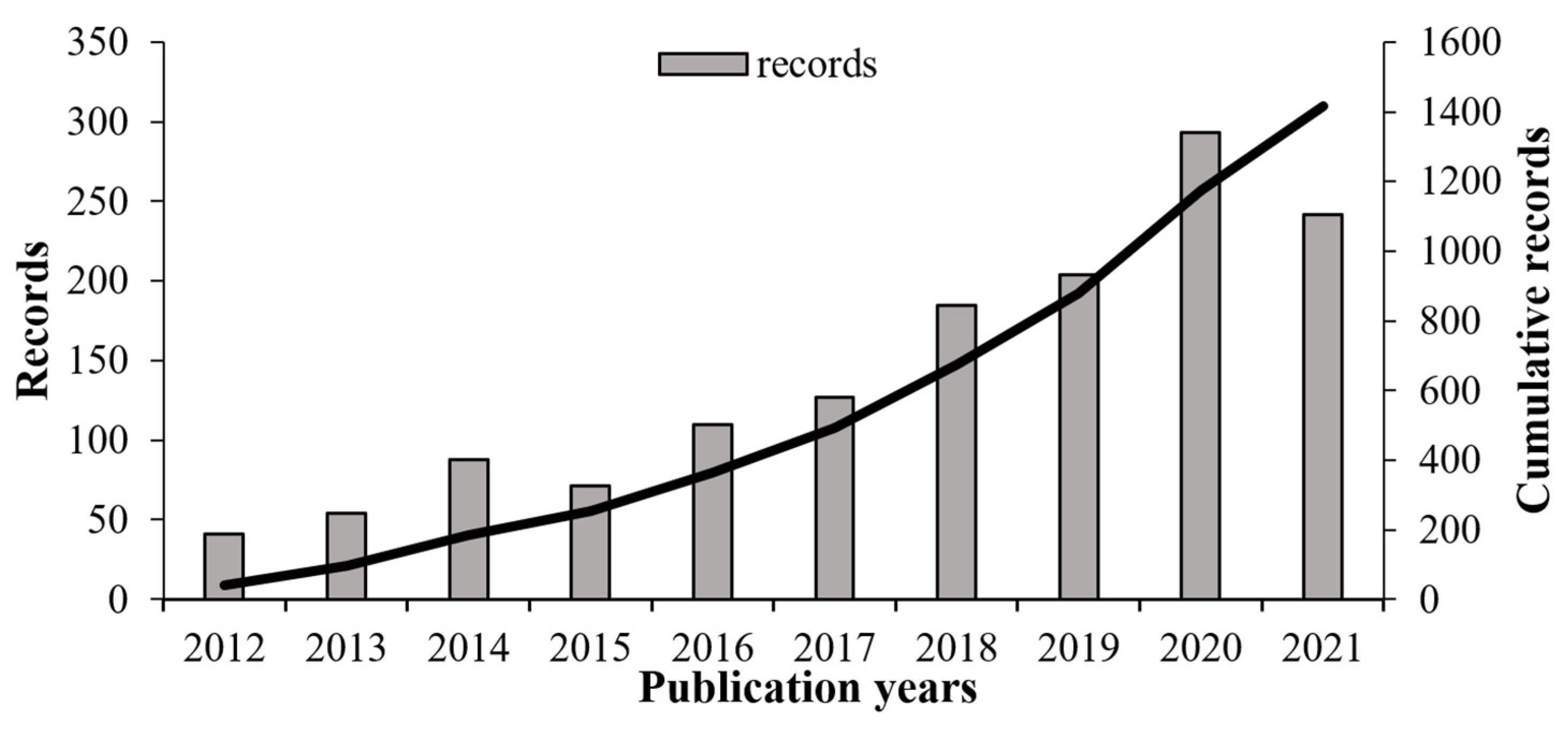
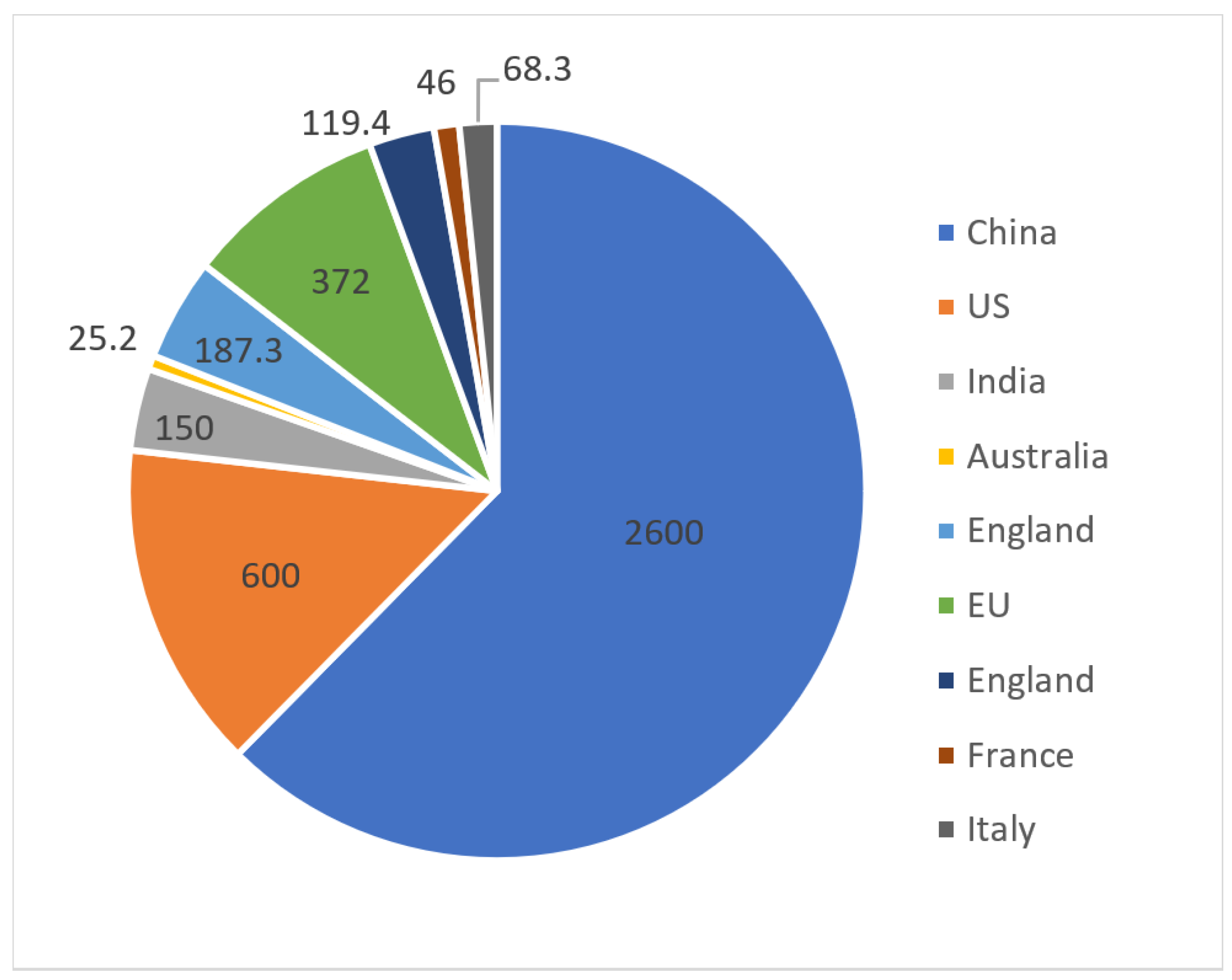
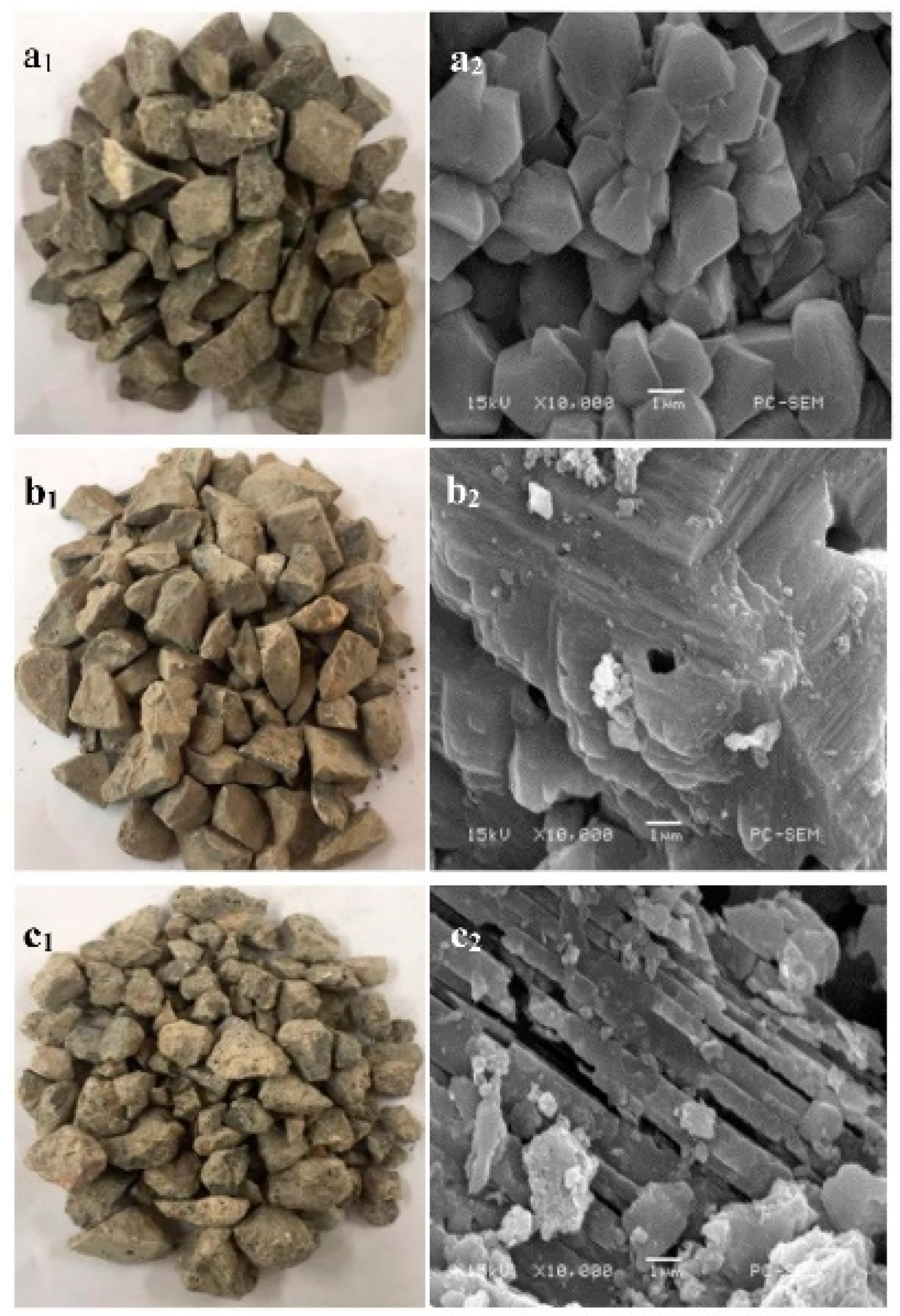
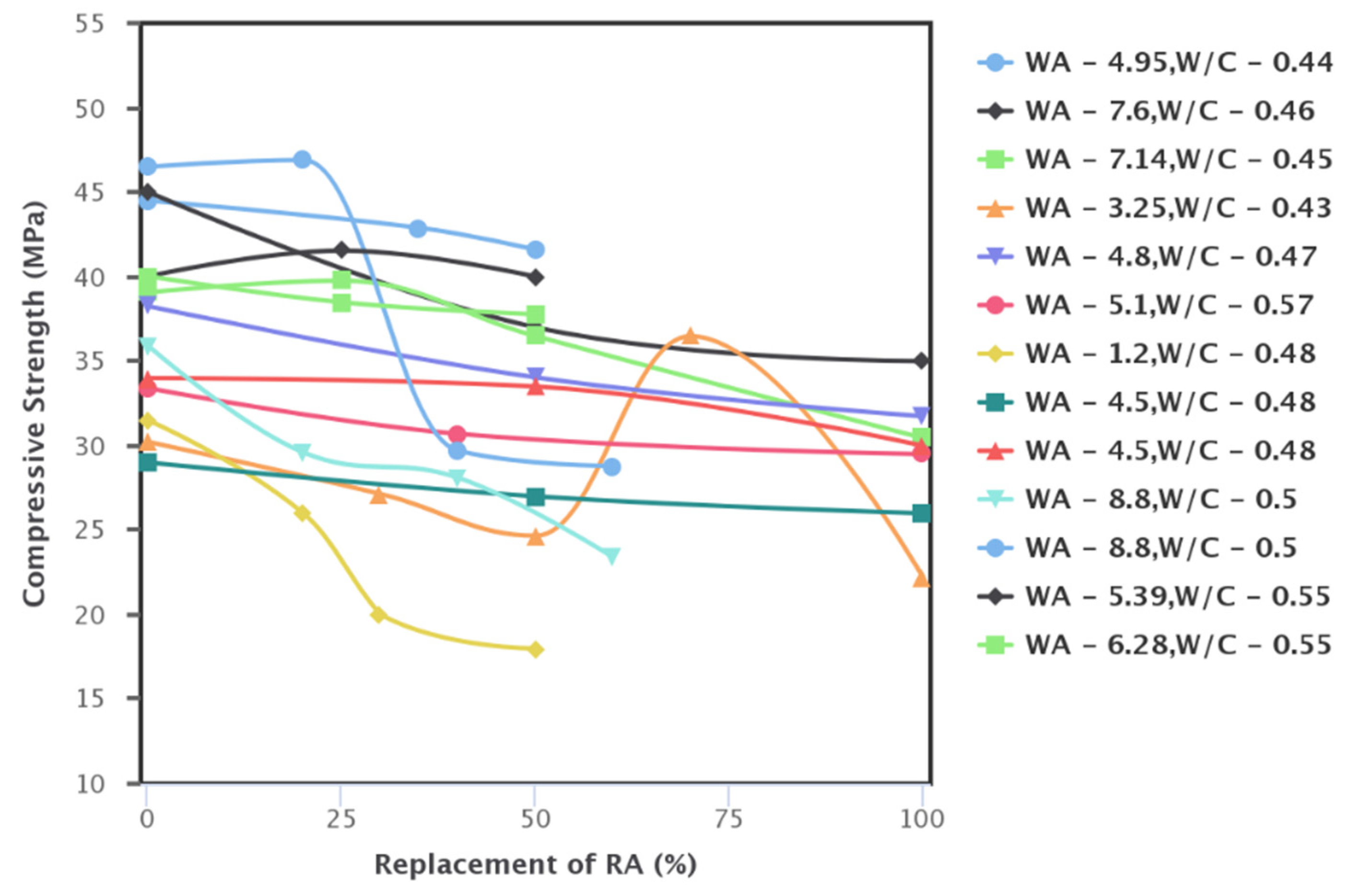
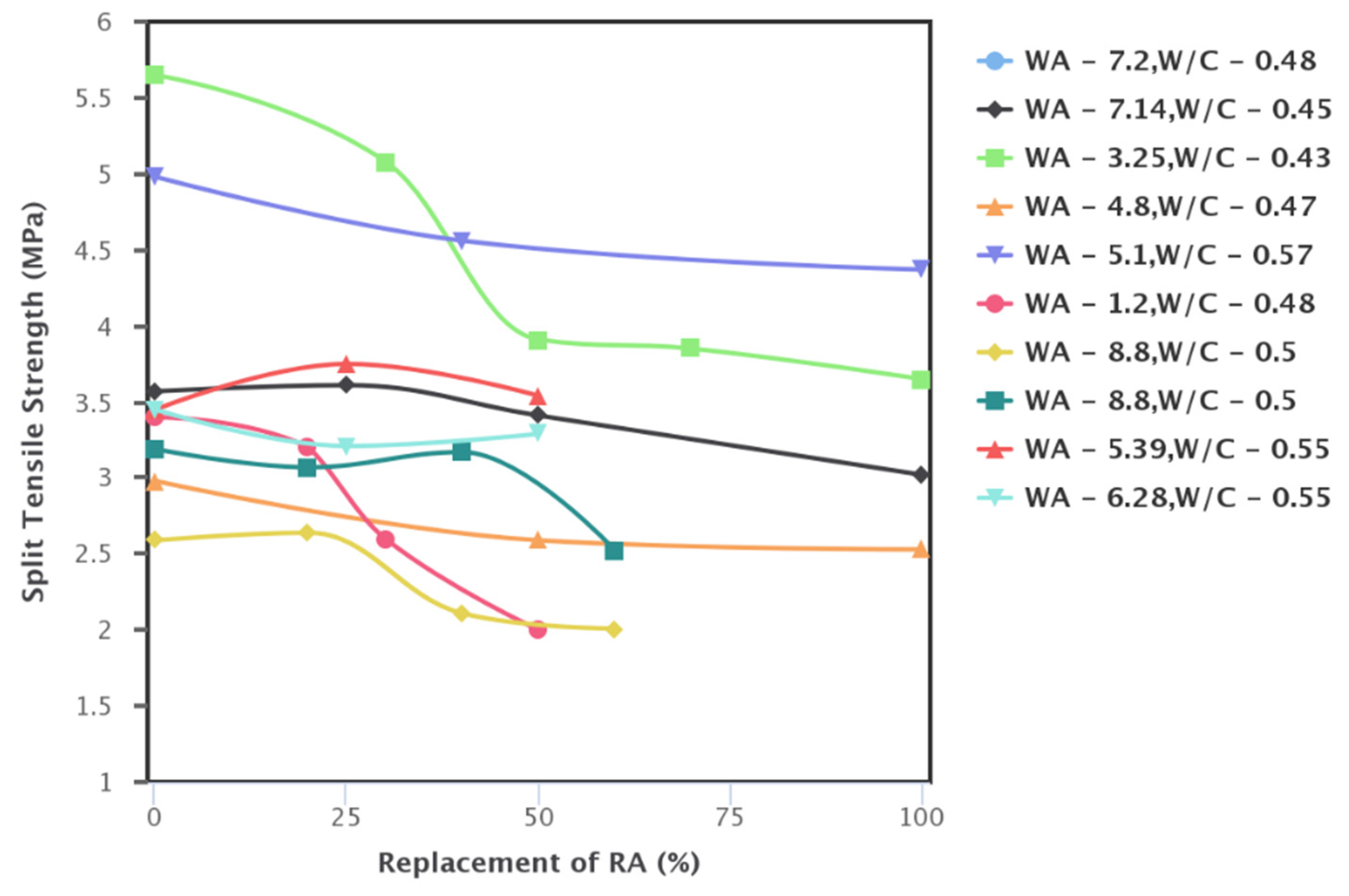
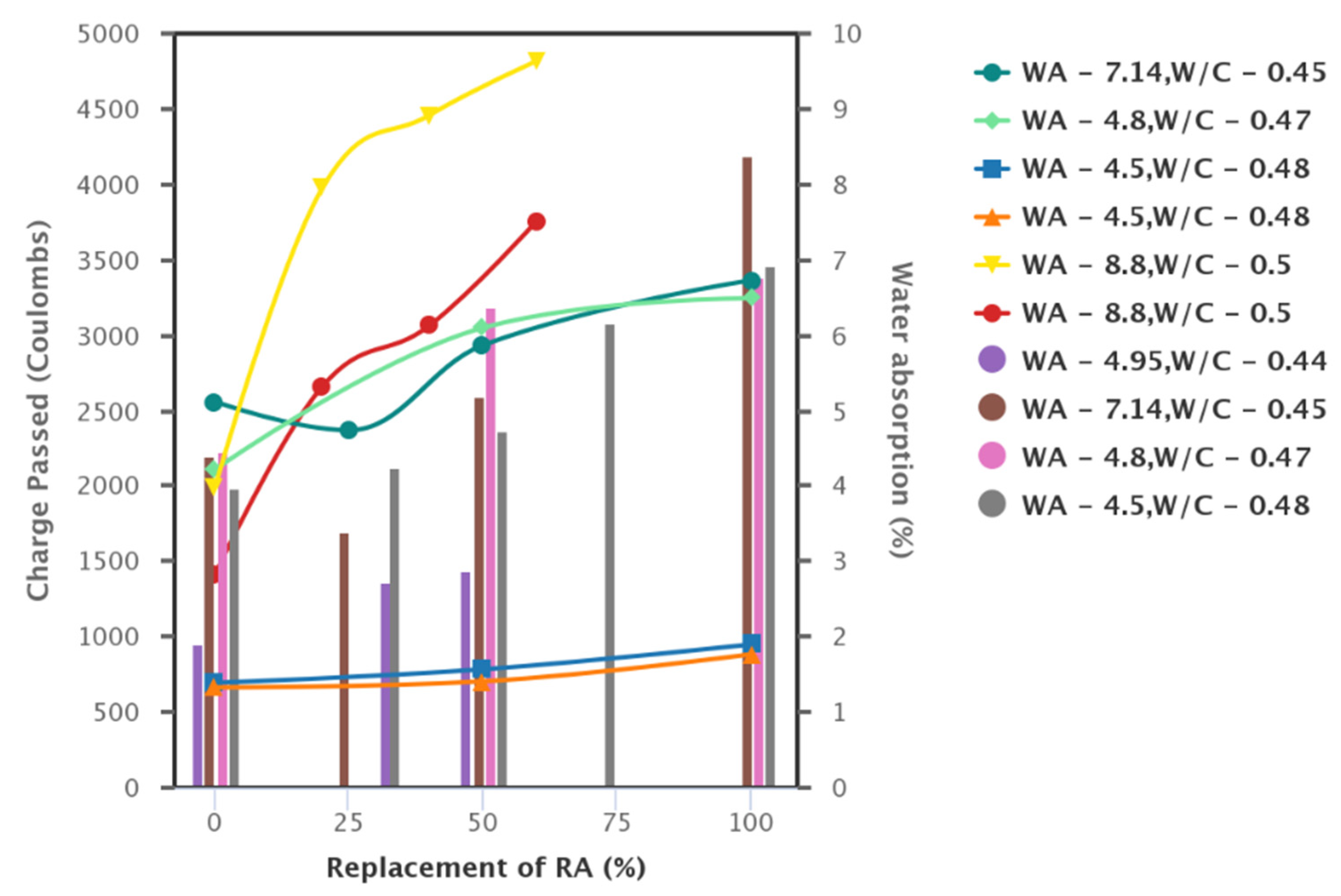
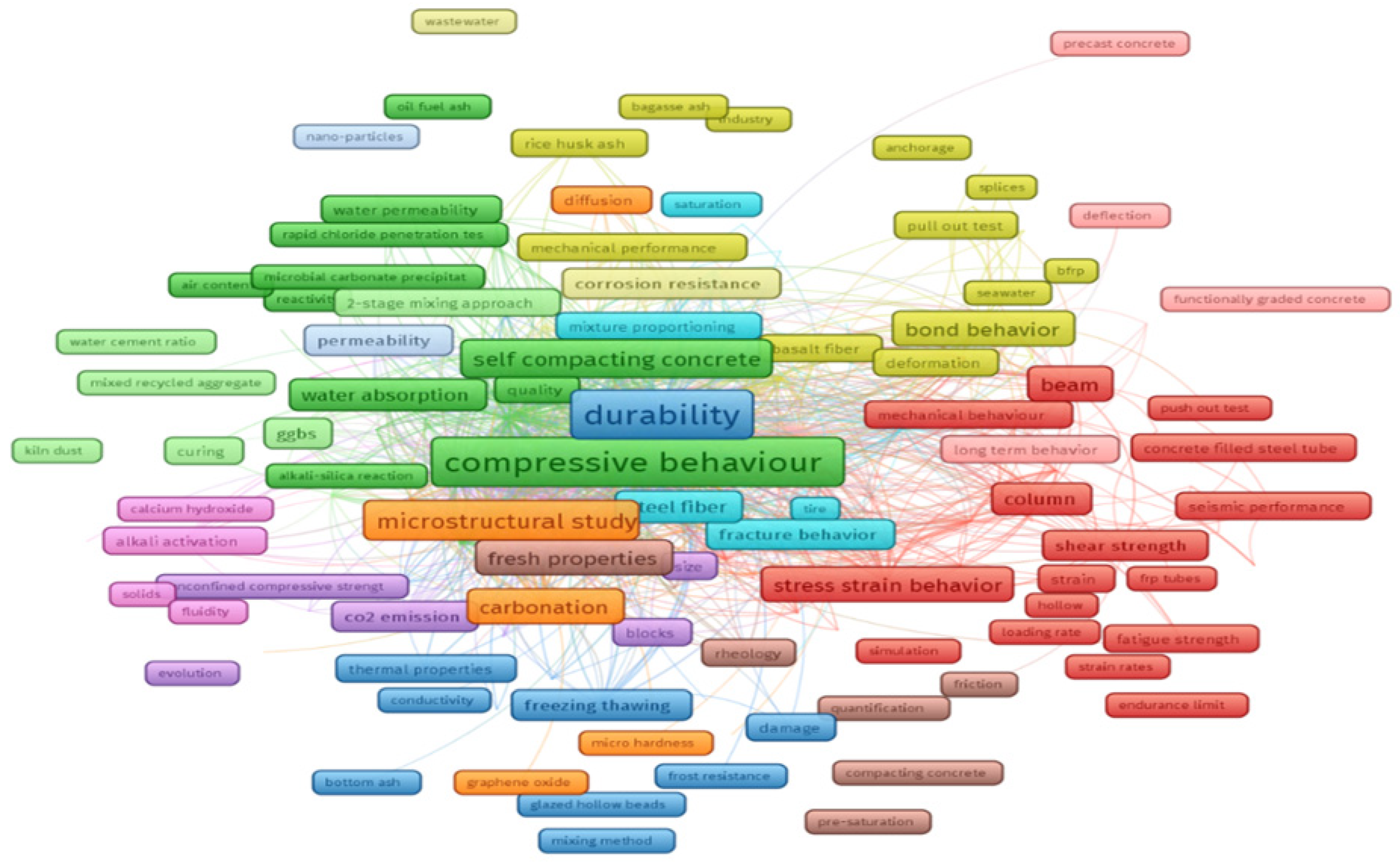
| Literature | Size (mm) | Aggregate Type | Unit Weight (kg/m3) | Specific Gravity | Water Absorption (%) | Crushing Value (%) | Flakiness Index (%) |
|---|---|---|---|---|---|---|---|
| Hamada et al. [44] | 4.75–25.4 | RCA | 1389 | 2.29 | 5.1 | - | - |
| 4.75–12.7 | RCA | 1376 | 2.35 | 4.8 | - | - | |
| Yu et al. [37] | 4–16 | RCA | 1230 | 3.21 | 21.26 | - | |
| Kumar et al. [45] | <4.75 | FMRA | 1290 | 2·08 | 11·91 | - | - |
| Cantero et al. [46] | 12–22 | MRA | - | - | 5.27 | - | 10 |
| 6–12 | MRA | - | - | 6.28 | - | 10 | |
| Yan et al. [32] | 5–26.5 | MRA | 1169 | - | 3.02 | 15.6 | - |
| 5–26.5 | RMA | 877 | - | 11.14 | 28.8 | - | |
| Meng et al. [32] | 9.75–31.5 | MRA | - | - | 8.8 | 18 | - |
| 0–9.5 | FMRA | - | - | 13.2 | 22 | - | |
| Sim et al. [47] | 5–25 | RCA | - | 2.55 | 1.68 | - | - |
| 0.15–5 | FRCA | - | 2.28 | 6.45 | - | - | |
| Guo et al. [48] | 5–31.5 | RCA | 1405 | - | 3.8 | - | - |
| 0.15–5 | FRCA | 1482 | - | 5.5 | - | - | |
| Raman et al. [49] | 4.75–20 | RCA | 1480 | 2.41 | 3.52 | 38.39 | |
| Babalola et al. [50] | 4.75–25 | RCA | 1490 | 2.35 | 5.2 | - | - |
| Saleem Kazmi et al. [33] | 4.75–20 | RCA | 1414 | 2.55 | 6.85 | 31 | - |
| Mahmood et al. [51] | 20–15 (40%) 15–5 (60%) | RCA | - | 2.43 | 4.5 | 47.82 | - |
| Literature | Aggregate Type | Treatment Methods | Before Treatment | After Treatment | Effects on Enhancement |
|---|---|---|---|---|---|
| WA (%), Density (ρ) (kg/m3) | |||||
| Zhan et al. [52] | RCA | Carbonation (Optimum treatment duration, 7 days; Pressure, 1 bar) | WA: 7.52 | WA: 5.76 | The treatment induced the carbonation of portlandite, resulting in an increase in calcium carbonates that filled the pore gaps and increased the density of the microstructure. |
| ρ: 2636 | ρ: 2700 | ||||
| Zeng et al. [53] | MRA | Soaking in a nano-silica suspension of 15% nano-silica particles by weight. (Optimum, 1 h of soaking) | WA: 8.22 | WA: 7.38 | The surface of the recycled aggregate would be penetrated and altered by nano-silica particles, increasing the density of the concrete microstructure. |
| ρ: 2566 | ρ: 2588 | ||||
| Al-Waked et al. [54] | MRA | Accelerated carbonation (5 days of carbonation treatment, 50% CO2 concentration) | WA: 6.1 | WA: 3.3 | This enhancement occurs due to the transformation of portlandite to calcite and the development of amorphous carbonation products. |
| Pretreatment using sodium silicate–silica fume solution (Optimum replacement level, 5%; soaking time, 4 h) | WA: 6.1 | WA: 4.1 | Immersion in a pozzolanic solution fills the pores of the RA and forms a C-S-H gel by mixing with CH crystals that fill the gaps in the recycled aggregate. | ||
| Al-Bayati et al. [55] | RCA | Heat treatment (Optimum heating, 350 °C) | WA: 5.91 | WA: 5.35 | High temperatures between 400 and 600 °C make the aggregate experience internal stress due to thermal expansion. |
| Soaking in HCl (0.1 M for 24 h) | WA: 5.91 | WA: 5.66 | A strong acid does not reduce the impact of acid attacks as effectively as a mild acid. | ||
| CRCA soaking in acetic acid (0.1 M for 24 h) | WA: 5.91 | WA: 5.79 | |||
| Wang et al. [12] | RCA | Treatment with a water-based liquid crystallizing agent (Optimum immersion, 7 d; aggregate/solution ratio, 2 kg/L) | WA: 7.13 | WA: 2.96 | When a crystallizing agent was added, C-S-H formed and minimized the porosity of the recycled concrete aggregate |
| Damrongwiriyanupap et al. [56] | RCA | Coating with cement paste | WA: 7.54 | WA: 3.25 | The development of calcium silicate hydrate can fill the gaps in the RCA. |
| Coating with a high-calcium fly ash paste that has been alkali-activated (10 M NaOH and Na2SiO3) | WA: 7.54 | WA: 2.10 | Unreacted cement grains in the RCA might react with water, fly ash, dolomite, SiO2, and Al2O3 to create hydration products at the interfacial transition zone. | ||
| Alkali activation of fly ash paste regulated by a dolomite coating (10 M NaOH and Na2SiO3. The dolomite was oven dried at 100 °C) | WA: 7.54 | WA: 2.55 | |||
| Reference | W/C Ratio | Aggregate Type | Replacement Level (%) | SP Dosage (%) and Type of SP | With or Without Admixture | Slump Value (mm) |  |
|---|---|---|---|---|---|---|---|
| Tangchirapat et al. [72] | 0.48 | CRCA | Up to 100 | - | - | Up to 70 (+16.7%) | |
| FRCA + CRCA | - | Up to 50 (−16.7%) | |||||
| CRCA | FA up to 50% | Up to 100 (+42.8%) | |||||
| FRCA + CRCA | FA up to 50% | Up to 90 (+80.0%) | |||||
| Kumar et al. [45] | 0.42 | FMRA | Up to 100 | 0·25 (polycarboxylate ether) | - | Up to 40 (−48.7%) | |
| Chih Fan et al. [73] | 0.35 | FRCA | Up to 100 | 1 (type G) | - | Up to 180 (−10.0%) | |
| 0.55 | - | Up to 195 (−9.7%) | |||||
| de Andrade et al. [74] | 0.45 | FRCA | Up to 100 | 0.4 (Glenium 51) | - | Up to 165 (+153.8%) | |
| Cantero et al. [75] | 0.45 | MRA | Up to 100 | 1.55 (water-based polycarboxylate) | - | Up to 140 (+27.27%) | |
| SI. No | Literature | Replacement Level (%) | Additives | Effects on Strength Parameters |
|---|---|---|---|---|
| 1. | Hamad et al. [44] | 0, 40, and100 | – | CS *: 33.4, 30.7, and 29.5 MPa STS **: 4.98, 4.56, and 4.37 MPa Modulus of elasticity: 31,602.1, 27,130.7, and 28,596.8 MPa Flexural strength: 196.8, 213.7, and 227.2 kN Shear strength: 162.9, 162.8, and 159.3 kN Bond strength: 119.2, 137.9, and 121.2 kN for 0, 40, and 100% RCA, respectively. |
| 2. | Zhang et al. [41] | 100% RCA | Carbonation treatment | Carbonated aggregate showed 15 and 10% higher CS 7 and 28 days after treatment, respectively. |
| 3. | Faysal et al. [42] | 60% RCA | SCM with a two-stage mixing approach (TSMA and SCM containing fly ash (20%), GGBS (20%), and silica fume (7%) | Silica fume containing a concrete mixture
|
| 4. | Sunayanaet al. [82] | 100% RA | 20 and 30% fly ash | RAC with 30% fly ash reduced:
|
| 5. | Guo et al. [83] | 50 and 100% RCA | 50 and 75% by weight of quaternary cementitious materials: cement, fly ash (FA), slag, and silica fume (SF) | 100% recycled aggregate concrete with quaternary cementitious materials increased the CS:
|
| 6 | Gholampour et al. [78] | 50% RFA | GGBS and fly ash | The RFA50 mix with 35% GGBS increased the CS:
|
| 7. | Kumar and Singh [84] | RCA at 0, 25, 50, 75, and 100% | 10% coal bottom ash and 50% fly ash | RCA specimens with 50% fly ash and 10% coal bottom ash reduced:
|
| Literature | Aggregate Type and Replacement Level | Admixture Dosage and Grade or W/C of Concrete | Admixture/ RA Optimum Dosage | CS | STS | FS | RCPT | WPT |
|---|---|---|---|---|---|---|---|---|
| (%) | (%) | (%) | MPa at 28 Days | Coulombs | mm or % | |||
| Dimitriou et al. [93] | MRA (0, 50, 100) | W/C: 0.48 | - | Up to 47.1 (−34.7%) | Up to 3.1 (−26.2%) | Up to 6.6 (−23.6%) | Up to 5248 (+51.1%) | - |
| MRA (100) | FA: 25 | - | 35.6 (−50.6%) | 2.0 (−52.4%) | 6.3 (−26.7%) | Up to 5303 (+52.7%) | - | |
| FA: 25 and SF: 5 | - | 38.2 (−47%) | 2.2 (−47.6%) | 6.3 (−26.7%) | Up to (−0.2%) | - | ||
| Sivamani et al. [33] | FMRA 0, 25, 50, 100 | W/C: 0.45 | 25 | Up to 30.45 (−22.1%) | Up to 3.0 (−22.1) | Up to 3.86 (−11.9%) | Up to 4200 (+90.9%) | Up to 6.73% (+31.4%) |
| Khan et al. [88] | RCA 0, 30, 50, 70, 100 | W/C: 0.43 | 30 | Up to 22.22 (−26.5%) | Up to 3.65 (−35.4%) | Up to 4.03 (−38.5%) | - | Up to 30 mm (+200%) |
| Cantero et al. [94] | MRA 0, 25, 50 75, 100 | Grade: 30 MPa | 75 | Up to 47.78 (−6.6%) | - | - | - | Up to 17 mm (+36%) |
| Yan et al. [95] | RCA 0, 30, 50, 100 | W/C: 0.45 | - | Up to 32.2 (−29.2%) | - | - | - | - |
| calcined nano-attapulgite (CNAT): 2, 4, 6, 8 | CNAT: 6%, RCA 50% | 2% CNAT: Up to 35.3 (−27.2%) 4% CNAT: Up to 37.5 (−24.7%) 6% CNAT: Up to 38.5 (−19.9%) 10% CNAT: Up to 38.8 (−13.4%) | - | - | - | - | ||
| Bhasya et al. [89] | RCA 0, 50, 100 | Grade: 30 MPa | - | Up to 31.74 (−17.0%) | - | - | Up to 3386 (+51.7%) | Up to 6.49% (+54.5%) |
| Saravanakumar et al. [96] | RCA 0, 25, 50, 100 | Grade: 50 MPa | - | Up to 33.78 (−37.1%) | Up to 3.21 (−34.4) | - | - | - |
| Fly ash (FA): 40, 50, 60 | 50%FA and 50% RCA | FA40%: Up to 27.41 (−26.3%) FA50%: Up to 26.74 (−19.7%) FA60%: Up to 22.23 (−17.1%) | FA40%: Up to 3.0 (−26.8%) FA50%: Up to 2.63 (−29.1%) FA60%: Up to 2.25 (−30.6%) | - | - | - | ||
| Dilbas et al. [91] | RCA 0, 20, 40, 60 | W/C: 0.5 | 20% RCA | Up to 23.4 (−34.8%) | Up to 2.01 (−22.4%) | - | - | Up to 9.64% (+142%) |
| Silica fume (SF): 5, 10 | 10% SF | SF 5: Up to 28.8 (−28%) SF 10: Up to 28.8 (−38.1%) | SF 5: Up to 2.6 (−13.1%) SF 10: Up to 2.5 (−21.0%) | - | - | SF 5: Up to 8.0% (+171.6%) SF 10: Up to 7.5 (+166.7%) | ||
| Barrag’an-Ramos et al. [97] | FRCA 0, 20, 60, 100 | W/C: 0.45 and 0.50 | 20 FRCA | W/C: 0.45: Up to 26 (−16.1%) W/C: 0.5: Up to 23 (−11.5%) | - | - | W/C: 0.45: Up to 8500 (+34.9%) W/C: 0.5: Up to 6900 (+16.9%) | - |
| FA: 20% | 20FA | W/C: 0.45 Up to 22 (−29.0%) W/C: 0.5 Up to 17 (−34.6%) | - | - | W/C: 0.45 Up to 5900 (−6.3%) W/C: 0.5 Up to 7000 (+18.6%) | - | ||
| Ju et al. [98] | FRCA 0, 50, 100 | Grade: 20 MPa | FRCA 50% | Up to 27.7 (−12.0%) | Up to 3.61 (−6.3%) | - | - | - |
| FA: 15, 30 GGBS: 20,40 SF: 2.5,5 | FA—30 GGBS—40 SF—5 | FA 15: Up to 32.8 (+4.5%) FA 30: Up to 21.7 (−31.0%) GGBS 20: Up to 32.8 (+4.3%) GGBS 40: Up to 27.5 (−12.5%) SF 2.5: Up to 33.6 (+6.9%) SF 5: Up to 21.6 (−31.3%) | FA 15: Up to 3.9 (+3.0%) FA 30: Up to 3.6 (−6.5%) GGBS 20: Up to 3.70 (+4.1%) GGBS 40: Up to 3.58 (−7.2%) SF 2.5: Up to 4.03 (+2.7%) SF 5: Up to 2.64 (−31.6%) | - | - | - | ||
| Kirthika et al. [37] | FMRA 0, 30, 50, 75, 100 | W/C: 0.50 | 30 | Up to 30.1 (−16.9%) | Up to 2.9 (−6.45%) | Up to 4.6 (+2.22%) | - | - |
| Joseph et al. [4] | CMRA 0, 30, 60, 100 | W/C: 0.42 | 30 | Up to 34.92 (−18.7%) | Up to 2.21 (−19%) | Up to 2.52 (−47.4%) | - | - |
| S. No | Pretreatment Technique | Advantages | Disadvantages |
|---|---|---|---|
| 1 | Nano-silica coating of RA [79] |
|
|
| 2 | Chemical and impregnation treatment (sodium silicate, silane slurry, and polyvinyl alcohol) [128] |
|
|
| 3 | Pozzolanic slurry impregnation (fly ash, GGBS, silica fume, and metakaolin) [129] |
|
|
| 4 | Carbonation treatment [130] |
|
|
| 5 | Heat and mechanical rubbing [131] |
|
|
| 6 | Acid treatment followed by mechanical grinding [66] |
|
|
| 7 | Bio deposition [132] |
|
|
Disclaimer/Publisher’s Note: The statements, opinions and data contained in all publications are solely those of the individual author(s) and contributor(s) and not of MDPI and/or the editor(s). MDPI and/or the editor(s) disclaim responsibility for any injury to people or property resulting from any ideas, methods, instructions or products referred to in the content. |
© 2023 by the authors. Licensee MDPI, Basel, Switzerland. This article is an open access article distributed under the terms and conditions of the Creative Commons Attribution (CC BY) license (https://creativecommons.org/licenses/by/4.0/).
Share and Cite
Joseph, H.S.; Pachiappan, T.; Avudaiappan, S.; Maureira-Carsalade, N.; Roco-Videla, Á.; Guindos, P.; Parra, P.F. A Comprehensive Review on Recycling of Construction Demolition Waste in Concrete. Sustainability 2023, 15, 4932. https://doi.org/10.3390/su15064932
Joseph HS, Pachiappan T, Avudaiappan S, Maureira-Carsalade N, Roco-Videla Á, Guindos P, Parra PF. A Comprehensive Review on Recycling of Construction Demolition Waste in Concrete. Sustainability. 2023; 15(6):4932. https://doi.org/10.3390/su15064932
Chicago/Turabian StyleJoseph, Herbert Sinduja, Thamilselvi Pachiappan, Siva Avudaiappan, Nelson Maureira-Carsalade, Ángel Roco-Videla, Pablo Guindos, and Pablo F. Parra. 2023. "A Comprehensive Review on Recycling of Construction Demolition Waste in Concrete" Sustainability 15, no. 6: 4932. https://doi.org/10.3390/su15064932
APA StyleJoseph, H. S., Pachiappan, T., Avudaiappan, S., Maureira-Carsalade, N., Roco-Videla, Á., Guindos, P., & Parra, P. F. (2023). A Comprehensive Review on Recycling of Construction Demolition Waste in Concrete. Sustainability, 15(6), 4932. https://doi.org/10.3390/su15064932








